Category Archives: terrystips
ABBV Not Immune to a Pullback

October 8, 2022
Pharmaceutical giant AbbVie (ABBV) reported mixed results in its recent earnings report. While earnings beat the consensus estimate, revenue fell short. Notably, the company’s immunology portfolio, which includes popular TV-ad drugs such as Humira, fell short of expectations. ABBV’s CEO cited the usual (and seemingly generic) “economic headwinds” as hurting the company’s aesthetic business (ABBVIE makes Botox).
While analysts didn’t hit ABBV with any downgrades, there was a flurry of target price decreases. The average estimate is now $157, about 8% above Friday’s close. That doesn’t seem unreasonable, nor is the average analyst rating, which has been slipping into the buy-hold region.
On the charts, ABBV’s earnings knocked the stock below its 200-day moving average, a trendline that has provided solid resistance to any rally attempts other than a brief spurt prior to earnings. This trade is thus a bet that the stock will continue to trade sideways as it has for the past six months, with the 200-day defining the upper rail of the trading range. Note that the short call of our spread is above the 200-day, so the stock will have to break this resistance to move the spread into the money.
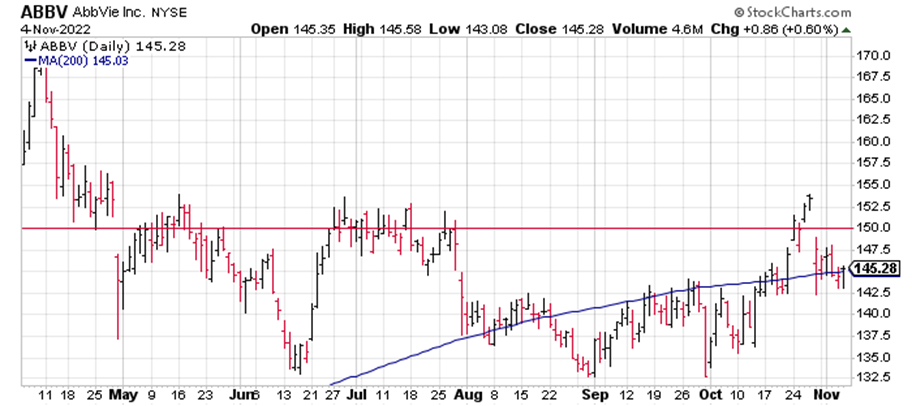
If you agree that ABBV will continue to respect the 200-day (blue line), consider the following trade that relies on the stock staying below $150 (red line) through expiration in six weeks:
Buy to Open the ABBV 16 Dec 155 call (ABBV221216C155)
Sell to Open the ABBV 16 Dec 150 call (ABBV221216C150) for a credit of $1.98 (selling a vertical)
This credit is $0.02 less than the mid-point price of the spread at Monday’s $148.10 close. Unless ABBV falls quickly, you should be able to get close to that price.
The commission on this trade should be no more than $1.30 per spread. Each spread would then yield $196.80. This trade reduces your buying power by $500, making your net investment $303.20 per spread ($500 – $196.80). If ABBV closes below $150 on Dec. 16, both options will expire worthless and your return on the spread would be 65% ($196.80/$303.20).
Making 36%
Making 36% – A Duffer's Guide to Breaking Par in the Market Every Year in Good Years and Bad
This book may not improve your golf game, but it might change your financial situation so that you will have more time for the greens and fairways (and sometimes the woods).
Learn why Dr. Allen believes that the 10K Strategy is less risky than owning stocks or mutual funds, and why it is especially appropriate for your IRA.
Success Stories
I have been trading the equity markets with many different strategies for over 40 years. Terry Allen's strategies have been the most consistent money makers for me. I used them during the 2008 melt-down, to earn over 50% annualized return, while all my neighbors were crying about their losses.
~ John Collins
Go With VLO

October 31, 2022
Go With VLO
Oil refiner Valero Energy (VLO) reported earnings this week that either missed or beat both profit and revenue estimates, depending on the source. I won’t quibble with who’s right or wrong. What’s important is that revenue and profits soared above the figures from a year ago. Moreover, VLO’s CEO said that product demand surpassed 2019 levels.
The report was met with target price increases from several analysts. What’s interesting about VLO compared to most stocks, though, is that the average target price is only 9% above Friday’s closing price. In other words, it’s reasonable. To me, that adds some weight to the price increases we saw this week.
On the charts, the stock is down a bit since earnings. But the month-long uptrend remains intact, assisted by the 20-day moving average. The shares have not closed a day below this trendline in October, a period that includes a pullback that tested support. Based on this support, we’re going with a put credit spread with the short put strike sitting right on the 20-day (blue line) and will soon be below it. Thus, the stock will have to break through the trendline to move the spread into the money.
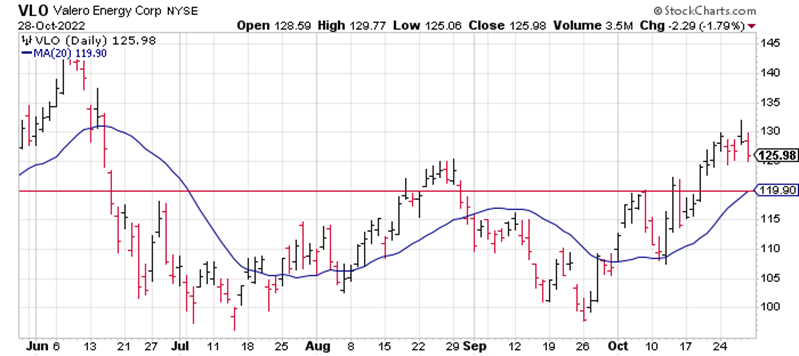
If you agree that VLO will continue to respect the 20-day, consider the following trade that relies on the stock staying above $120 (red line) through expiration in seven weeks:
Buy to Open the VLO 16 Dec 115 put (VLO221216P115)
Sell to Open the VLO 16 Dec 120 put (VLO221216P120) for a credit of $1.65 (selling a vertical)
This credit is $0.02 less than the mid-point price of the spread at Friday’s $125.98 close. Unless VLO surges quickly, you should be able to get close to that price.
The commission on this trade should be no more than $1.30 per spread. Each spread would then yield $163.70. This trade reduces your buying power by $500, making your net investment $336.30 per spread ($500 – $163.70). If VLO closes above $120 on Dec. 16, both options will expire worthless and your return on the spread would be 49% ($163.70/$336.30).
Making 36%
Making 36% – A Duffer's Guide to Breaking Par in the Market Every Year in Good Years and Bad
This book may not improve your golf game, but it might change your financial situation so that you will have more time for the greens and fairways (and sometimes the woods).
Learn why Dr. Allen believes that the 10K Strategy is less risky than owning stocks or mutual funds, and why it is especially appropriate for your IRA.
Success Stories
I have been trading the equity markets with many different strategies for over 40 years. Terry Allen's strategies have been the most consistent money makers for me. I used them during the 2008 melt-down, to earn over 50% annualized return, while all my neighbors were crying about their losses.
~ John Collins
Schwab Tested

October 24, 2022
Schwab (SCHW) reported earnings on Monday before the open that set records for both earnings per share and revenue. Both numbers exceeded the consensus analyst estimates. SCHW attributed the great quarter to its “diversified financial model and a significant benefit from higher rates.”
Analysts didn’t appear moved by the record numbers, though. There were no upgrades (nor downgrades), and just one price target decrease. Perhaps that’s because analysts have been overly bullish on a stock that is down 16% this year. Plus, analysts have an average price target that is 19% above Friday’s close.
Despite the earnings success, the stock didn’t do much in a week where the S&P 500 climbed nearly 5%. The stock couldn’t even manage a weekly gain of 2%, keeping it mired in a trading range that has persisted since late July. On the chart, the shares are looking up at the 20-day, 50-day and 200-day moving averages, all of which are pointing lower.
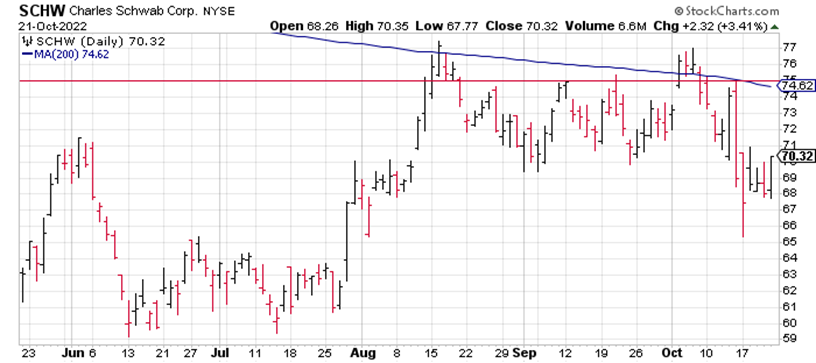
This trade is based on SCHW continuing to struggle in gaining any momentum now that earnings is past. Heavy overhead resistance should keep the stock contained. That’s why we’re going with a call credit spread with the short call strike sitting just above the 200-day moving average (blue line). Note that the 20-day and 50-day trendlines sit between the stock price and short strike, too.If you agree that SCHW will continue to trade sideways, consider the following trade that relies on the stock staying below $75 (red line) through expiration in five weeks:
Buy to Open the SCHW 25 Nov 77 call (SCHW221125C77)
Sell to Open the SCHW 25 Nov 75 call (SCHW221125C75) for a credit of $0.50 (selling a vertical)
This credit is $0.03 less than the mid-point price of the spread at Friday’s $70.32 close. Unless SCHW sags quickly, you should be able to get close to that price.
The commission on this trade should be no more than $1.30 per spread. Each spread would then yield $48.70. This trade reduces your buying power by $200, making your net investment $151.30 per spread ($200 – $48.70). If SCHW closes below $75 on Nov. 25, both options will expire worthless and your return on the spread would be 32% ($48.70/$151.30).
Making 36%
Making 36% – A Duffer's Guide to Breaking Par in the Market Every Year in Good Years and Bad
This book may not improve your golf game, but it might change your financial situation so that you will have more time for the greens and fairways (and sometimes the woods).
Learn why Dr. Allen believes that the 10K Strategy is less risky than owning stocks or mutual funds, and why it is especially appropriate for your IRA.
Success Stories
I have been trading the equity markets with many different strategies for over 40 years. Terry Allen's strategies have been the most consistent money makers for me. I used them during the 2008 melt-down, to earn over 50% annualized return, while all my neighbors were crying about their losses.
~ John Collins
On The Rocks

October 18, 2022
BlackRock (BLK) is the world’s largest asset manager with more than $10 trillion in assets under management (AUM) heading into 2022. But that has changed dramatically, as evidenced by Thursday’s release of BLK’s latest earnings report that showed AUM tumbling 16% in the third quarter. The Ukraine war, high inflation, rising interest rates and the strong dollar were all cited as reasons why investors were pulling money from BLK funds. The company is also receiving backlash for its support of environment, social and governance (ESG) initiatives.
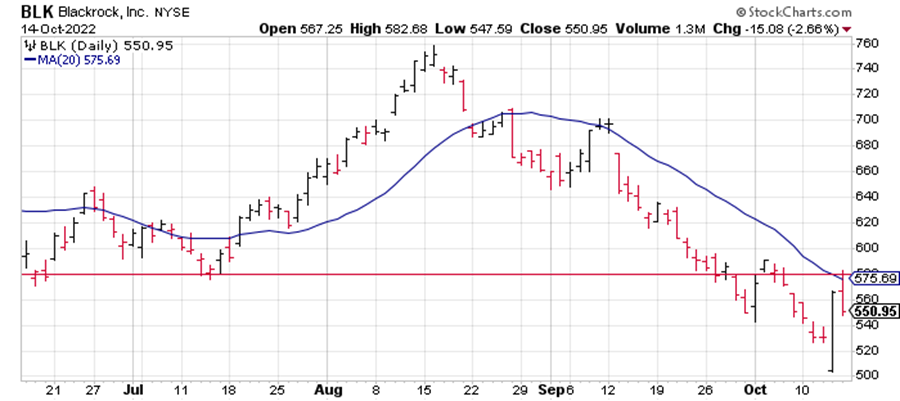
The stock gained ground the day after the report, but that was on “Bonkers Thursday” when a huge rising tide lifted all stocks. BLK retreated on Friday after encountering solid resistance at its 20-day moving average (blue line). This continues a downtrend that has been intact since mid-August. The slide has been perfectly contained by the 20-day, which hasn’t allowed a daily close above it in nearly two months. The stock is also down 40% this year, despite 75% of covering analysts rating the stock a buy.
This bearish trade is a bet that the problems plaguing BLK won’t go away any time soon. We’re going with a call credit spread with the short call sitting above the 20-day, meaning the stock will have to pierce this resistance to move the spread into the money.
If you agree that BLK will continue to decline under the weight of the 20-day, consider the following trade that relies on the stock staying below $580 (red line) through expiration in six weeks:
Buy to Open the BLK 25 Nov 590 call (BLK221125C590)
Sell to Open the BLK 25 Nov 580 call (BLK221125C580) for a credit of $3.40 (selling a vertical)
This credit is $0.10 less than the mid-point price of the spread at Friday’s $550.95 close. Unless BLK sags quickly, you should be able to get close to that price.
The commission on this trade should be no more than $1.30 per spread. Each spread would then yield $338.70. This trade reduces your buying power by $1,000, making your net investment $661.30 per spread ($1,000 – $338.70). If BLK closes below $580 on Nov. 25, both options will expire worthless and your return on the spread would be 51% ($338.70/$661.30).
Making 36%
Making 36% – A Duffer's Guide to Breaking Par in the Market Every Year in Good Years and Bad
This book may not improve your golf game, but it might change your financial situation so that you will have more time for the greens and fairways (and sometimes the woods).
Learn why Dr. Allen believes that the 10K Strategy is less risky than owning stocks or mutual funds, and why it is especially appropriate for your IRA.
Success Stories
I have been trading the equity markets with many different strategies for over 40 years. Terry Allen's strategies have been the most consistent money makers for me. I used them during the 2008 melt-down, to earn over 50% annualized return, while all my neighbors were crying about their losses.
~ John Collins
Underspiced

Spice maker McCormick (MKC) reported earnings this week that had no sizzle. Revenue and earnings both missed expectations by more than a little. The CEO said that “supply chain challenges continued, and recovery of certain constrained materials has taken longer than expected.” I’m not sure what that specifically means, but it doesn’t sound good.
The stock reacted with a brief burst on Thursday, but eventually finished lower. This shouldn’t be a surprise, though, as the stock has been in a pronounced decline since mid-August. The downtrend has covered more than 20%, pulling MKC to its lowest level since the COVID crash in early 2020. Moreover, the descent has been perfectly contained by the 20-day moving average, which hasn’t allowed a single close above it since Aug. 23.
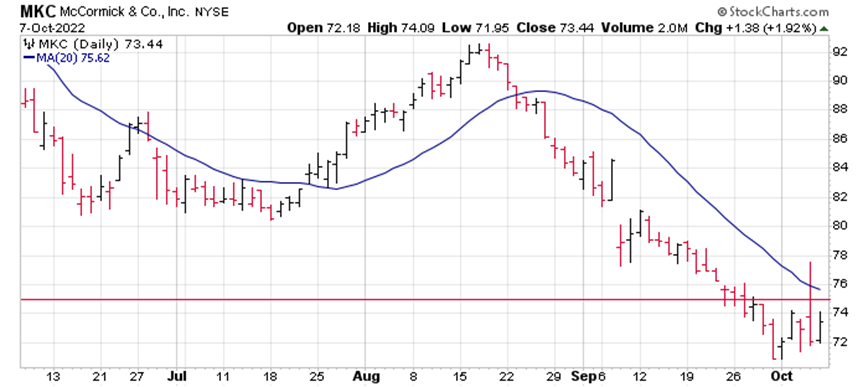
If you agree that MKC will continue to decline under the weight of the 20-day (blue line), consider the following trade that relies on the stock staying below $75 (red line) through expiration in six weeks:
Buy to Open the MKC 18 Nov 80 call (MKC221118C80)
Sell to Open the MKC 18 Nov 75 call (MKC221111C75) for a credit of $1.45 (selling a vertical)
This credit is $0.05 less than the mid-point price of the spread at Friday’s $73.44 close. Unless MKC sags quickly, you should be able to get close to that price.
The commission on this trade should be no more than $1.30 per spread. Each spread would then yield $143.70. This trade reduces your buying power by $500, making your net investment $356.30 per spread ($500 – $143.70). If MKC closes below $75 on Nov. 18, both options will expire worthless and your return on the spread would be 40% ($143.70/$356.30).
Making 36%
Making 36% – A Duffer's Guide to Breaking Par in the Market Every Year in Good Years and Bad
This book may not improve your golf game, but it might change your financial situation so that you will have more time for the greens and fairways (and sometimes the woods).
Learn why Dr. Allen believes that the 10K Strategy is less risky than owning stocks or mutual funds, and why it is especially appropriate for your IRA.
Success Stories
I have been trading the equity markets with many different strategies for over 40 years. Terry Allen's strategies have been the most consistent money makers for me. I used them during the 2008 melt-down, to earn over 50% annualized return, while all my neighbors were crying about their losses.
~ John Collins
Chip Dip

Micron Technology (MU) reported earnings on Thursday after the close, and the results were less than encouraging. Revenue was down 21% from a year ago, while earnings came in nearly a dollar less per share (though EPS did beat expectations). Profit and revenue projections for the next quarter came in well below analyst estimates. “Rapidly weakening consumer demand and significant customer inventory adjustments across all end markets” is not what you want to hear in an earnings report.
The stock did little after the report, though that may be due to news that Japan granted MU a $32 million subsidy to make chips at its Hiroshima plant. Nevertheless, the earnings and guidance news were met with a series of price target downgrades. Oddly, there was just one rating change … an upgrade. But analysts have been on the wrong side of MU for a while. The current average rating is a buy, with 28 of 31 analysts giving the stock a buy or better rating. This on a stock that is down 46% this year and just hit a 2-year low this week.
The stock is currently on a two-month slide that has pulled it 22% lower. The decline has been expertly guided by the 20-day moving average, which has not allowed a daily close above it since Aug. 18. This trendline (blue line) currently sits at 52.65, just above the short strike of our call spread. This trade is relying on the continued resistance of the 20-day and the assumption that MU’s fortunes are not going to suddenly reverse within the next few weeks.

If you agree that MU will continue to decline under the weight of the 20-day, consider the following trade that relies on the stock staying below $52.50 (red line) through expiration in seven weeks:
Buy to Open the MU 18 Nov 55 call (MU221118C55)
Sell to Open the MU 18 Nov 52.5 call (MU221111C52.5) for a credit of $0.85 (selling a vertical)
This credit is $0.03 less than the mid-point price of the spread at Friday’s $50.10 close. Unless MU sags quickly, you should be able to get close to that price.
The commission on this trade should be no more than $1.30 per spread. Each spread would then yield $83.70. This trade reduces your buying power by $300, making your net investment $216.30 per spread ($300 – $83.70). If MU closes below $52.50 on Nov. 18, both options will expire worthless and your return on the spread would be 39% ($83.70/$216.30).
Making 36%
Making 36% – A Duffer's Guide to Breaking Par in the Market Every Year in Good Years and Bad
This book may not improve your golf game, but it might change your financial situation so that you will have more time for the greens and fairways (and sometimes the woods).
Learn why Dr. Allen believes that the 10K Strategy is less risky than owning stocks or mutual funds, and why it is especially appropriate for your IRA.
Success Stories
I have been trading the equity markets with many different strategies for over 40 years. Terry Allen's strategies have been the most consistent money makers for me. I used them during the 2008 melt-down, to earn over 50% annualized return, while all my neighbors were crying about their losses.
~ John Collins
Housing Poor

Housing Poor
Homebuilding stocks got a boost early in the week after a prominent housing analyst upgraded the entire sector, including a rare “double upgrade” for Lennar (LEN) from underweight to overweight. The rationale was that housing tends to outperform coming out of a bear market and that “early pain = early gain.”
Now, he could very well be right … at some point. Housing stocks, along with the broader market, will eventually pull out of this bear market. But that’s off in the future. We’re still in the “early pain” phase.
LEN got a boost from the news but then trended lower after a mixed earnings report and another 75 bps rate hike from the Fed (with more to come). The stock could not pierce its declining 20-day moving average (blue line), which has kept a lid on LEN’s rally attempts after turning lower two months ago. Furthermore, the 50-day moving average (red line), which is now headed lower, sits overhead, ready to provide resistance.
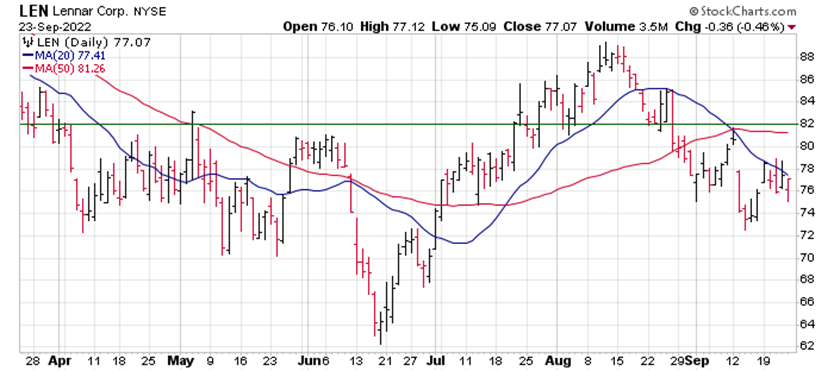
This trade is based on more “early pain” for the homebuilders based on rising interest rates, mortgage rates at 14-year highs and the looming prospect of a recession. We are playing a call credit spread with the short call sitting above the 50-day, meaning that LEN will have to overcome two points of resistance to move the spread into the money.
If you agree that LEN will continue to slide lower, consider the following trade that relies on the stock staying below $82 (green line) through expiration in six weeks:
Buy to Open the LEN 4Nov 85 call (LEN221104C85)
Sell to Open the LEN 4Nov 82 call (LEN221104C82) for a credit of $1.05 (selling a vertical)
This credit is $0.02 less than the mid-point price of the spread at Friday’s $77.07 close. Unless LEN sags quickly, you should be able to get close to that price.
The commission on this trade should be no more than $1.30 per spread. Each spread would then yield $103.70. This trade reduces your buying power by $300, making your net investment $196.30 per spread ($300 – $103.70). If LEN closes below $82 on Nov. 4, both options will expire worthless and your return on the spread would be 53% ($103.70/$196.30).
Making 36%
Making 36% – A Duffer's Guide to Breaking Par in the Market Every Year in Good Years and Bad
This book may not improve your golf game, but it might change your financial situation so that you will have more time for the greens and fairways (and sometimes the woods).
Learn why Dr. Allen believes that the 10K Strategy is less risky than owning stocks or mutual funds, and why it is especially appropriate for your IRA.
Success Stories
I have been trading the equity markets with many different strategies for over 40 years. Terry Allen's strategies have been the most consistent money makers for me. I used them during the 2008 melt-down, to earn over 50% annualized return, while all my neighbors were crying about their losses.
~ John Collins
Pumped Up

Pumped Up
Much is made of gas prices declining for so many weeks in a row (I think we’re at 13 and counting). And that’s great for drivers. But what about the oil companies. Don’t they suffer when pump prices decline? Apparently not.
Gas prices peaked in mid-June and have dropped about 25% since then. But Chevron (CVX) has gained more than 5% during that period. For the year, CVX is up 33%. Its only major blip this year was the June swoon that pulled all stocks lower. But the decline was supported by the 200-day moving average, which allowed just a handful of daily closes below it in mid-July.
This trade is based on the strength of oil companies continuing for the next couple of months. More specifically, it is relying on the continued support of the 200-day. Note that the short put of our spread is right on the 200-day (blue line) and will be below it given the trendline’s current slope. Thus, CVX will have to penetrate that support to move the spread into the money.
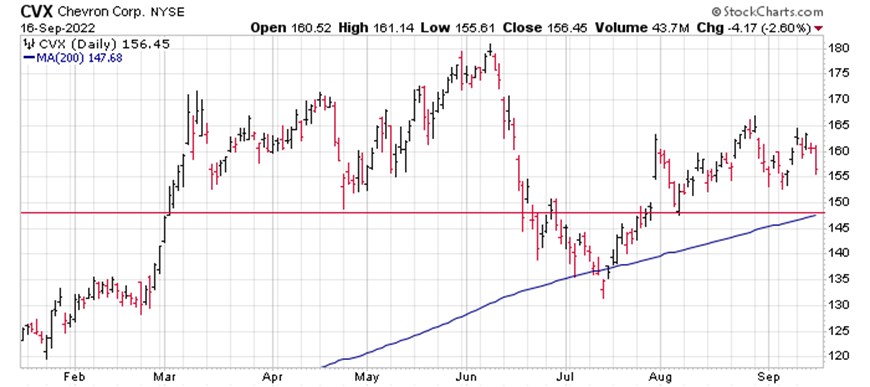
If you agree that CVX will respect the 200-day, consider the following trade that relies on the stock staying above $148 (red line) through expiration in six weeks:
Buy to Open the CVX 28Oct 145 put (CVX221028P145)
Sell to Open the CVX 28Oct 148 put (CVX221028P148) for a credit of $0.75 (selling a vertical)
This credit is $0.05 less than the mid-point price of the spread at Friday’s $156.45 close. Unless CVX pops quickly, you should be able to get close to that price.
The commission on this trade should be no more than $1.30 per spread. Each spread would then yield $73.70. This trade reduces your buying power by $300, making your net investment $226.30 per spread ($300 – $73.70). If CVX closes above $148 on October 28, both options will expire worthless and your return on the spread would be 33% ($73.70/$226.30).
Making 36%
Making 36% – A Duffer's Guide to Breaking Par in the Market Every Year in Good Years and Bad
This book may not improve your golf game, but it might change your financial situation so that you will have more time for the greens and fairways (and sometimes the woods).
Learn why Dr. Allen believes that the 10K Strategy is less risky than owning stocks or mutual funds, and why it is especially appropriate for your IRA.
Success Stories
I have been trading the equity markets with many different strategies for over 40 years. Terry Allen's strategies have been the most consistent money makers for me. I used them during the 2008 melt-down, to earn over 50% annualized return, while all my neighbors were crying about their losses.
~ John Collins
Warp Speed for This Lithium Producer

September 12, 2022
Warp Speed for This Lithium Producer
Sociedad Quimica y Minera de Chile (SQM) producers highly sought after commodities, most notably lithium and potassium fertilizers. Though it missed on earnings in its August earnings report, it easily beat on sales. A couple of analysts raised their price target after the news, though the overall mood toward the stock is between a buy and a hold.
But what do analysts know? SQM is up 120% this year (not a typo) … and it pays a dividend of more than 11%. The stock has recovered what it lost following earnings and came within four cents of hitting an all-time high in Friday’s trading. Though it has traded mostly sideways for the past three months, the overall uptrend remains intact, as the stock continues to put in higher lows. Plus, its 20-day and 50-day moving averages are pointed higher.
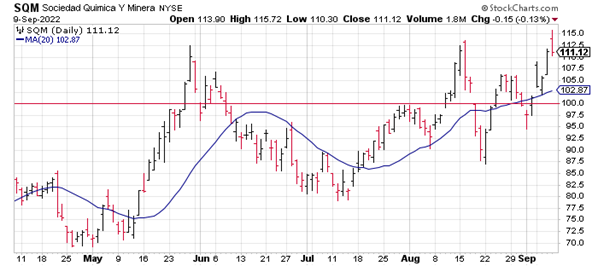
This trade is a play on SQM’s continued strength as it sits in one of the most favorable sectors within the global economy – supplying EV battery makers. We are thus going with a put credit spread with the short put sitting below the 20-day moving average (blue line).
If you agree that SQM will continue its uptrend, consider the following trade that relies on the stock staying above $100 (red line) through expiration in six weeks:
Buy to Open the SQM 21Oct 95 put (SQM221021P95)
Sell to Open the SQM 21Oct 100 put (SQM221021P100) for a credit of $1.10 (selling a vertical)
This credit is $0.02 less than the mid-point price of the spread at Friday’s $111.12 close. Unless SQM pops quickly, you should be able to get close to that price.
The commission on this trade should be no more than $1.30 per spread. Each spread would then yield $108.70. This trade reduces your buying power by $500, making your net investment $391.30 per spread ($500 – $108.70). If SQM closes above $100 on October 21, both options will expire worthless and your return on the spread would be 28% ($108.70/$391.30).
Making 36%
Making 36% – A Duffer's Guide to Breaking Par in the Market Every Year in Good Years and Bad
This book may not improve your golf game, but it might change your financial situation so that you will have more time for the greens and fairways (and sometimes the woods).
Learn why Dr. Allen believes that the 10K Strategy is less risky than owning stocks or mutual funds, and why it is especially appropriate for your IRA.
Success Stories
I have been trading the equity markets with many different strategies for over 40 years. Terry Allen's strategies have been the most consistent money makers for me. I used them during the 2008 melt-down, to earn over 50% annualized return, while all my neighbors were crying about their losses.
~ John Collins
For Whom the Bear Tolls

August 29 2022
For Whom the Bear Tolls
This is not a great time to be a homebuilder. The housing boom is over by most accounts. Consumer confidence in the housing market dropped to its lowest point since 2011. Sales of new homes plunged to a 6-1/2-year low in July. The Fed is not letting up on its interest-rate crusade. Do I need to go on?
Toll Brothers (TOL) echoed this sentiment in its recent earnings report. Although net income rose sharply in the third quarter and beat the analyst consensus estimate, revenue came up a bit short. More importantly, the homebuilder expects to deliver about 1,000 fewer units in fiscal 2022 than previously estimated.
TOL didn’t do much after earnings this week. In fact, it hasn’t done much for the past several months. The stock has been trading sideways for five months, with the top of the range around the $50 level. The fact that the shares couldn’t gain ground when housing was hot and interest rates low does not bode well for the future. Thus, we are going with a bearish call spread with the short call at the top of this trading range.
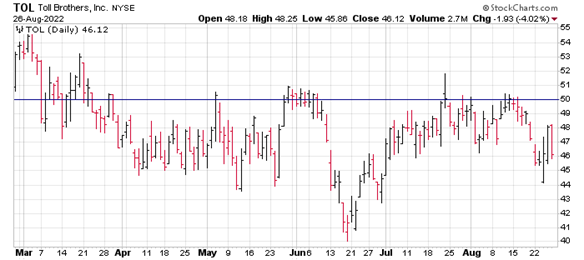
If you agree that TOL will continue sideways at best and lower at worst, consider the following trade that relies on the stock staying below $50 (blue line) through expiration in six weeks:
Buy to Open the TOL 7Oct 52 call (TOL221007C52)
Sell to Open the TOL 7Oct 50 call (TOL221007C50) for a credit of $0.45 (selling a vertical)
This credit is $0.02 less than the mid-point price of the spread at Friday’s $46.12 close. Unless TOL falls quickly, you should be able to get close to that price.
The commission on this trade should be no more than $1.30 per spread. Each spread would then yield $43.70. This trade reduces your buying power by $200, making your net investment $156.30 per spread ($200 – $43.70). If TOL closes below $50 on October 7, both options will expire worthless and your return on the spread would be 28% ($43.70/$156.30).
Making 36%
Making 36% – A Duffer's Guide to Breaking Par in the Market Every Year in Good Years and Bad
This book may not improve your golf game, but it might change your financial situation so that you will have more time for the greens and fairways (and sometimes the woods).
Learn why Dr. Allen believes that the 10K Strategy is less risky than owning stocks or mutual funds, and why it is especially appropriate for your IRA.
Success Stories
I have been trading the equity markets with many different strategies for over 40 years. Terry Allen's strategies have been the most consistent money makers for me. I used them during the 2008 melt-down, to earn over 50% annualized return, while all my neighbors were crying about their losses.
~ John Collins
Making 36%
Making 36% – A Duffer's Guide to Breaking Par in the Market Every Year in Good Years and Bad
This book may not improve your golf game, but it might change your financial situation so that you will have more time for the greens and fairways (and sometimes the woods).
Learn why Dr. Allen believes that the 10K Strategy is less risky than owning stocks or mutual funds, and why it is especially appropriate for your IRA.
Success Stories
I have been trading the equity markets with many different strategies for over 40 years. Terry Allen's strategies have been the most consistent money makers for me. I used them during the 2008 melt-down, to earn over 50% annualized return, while all my neighbors were crying about their losses.
~ John Collins

Follow Terry's Tips on Twitter
Like Terry's Tips on Facebook
Watch Terry's Tips on YouTube